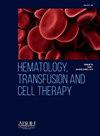ANTIPROLIFERATIVE ACTIVITIES IN VITRO OVER SQUAMOUS CELL CARCINOMAS OF A PALLADIUM(II) COMPLEX WITH AMANTADINE
IF 1.8
Q3 HEMATOLOGY
引用次数: 0
Abstract
Introduction/Justification
Metal-based drugs have been used in diagnosis and treatment of different types of cancer since the discovery of cisplatin's antineoplastic properties in the 1960’s. Second-generation drugs based on the platinum(II) complex cisplatin, such as carboplatin and oxaliplatin, were developed and used for cancer treatment worldwide. However, platinum(II) drugs typically cause side effects, such as nephrotoxicity, neurotoxicity and myelosuppression, which motivates the search for new drug candidates. Since the platinum(II) and palladium(II) ions have similar characteristics and form analogous compounds, palladium(II) complexes have been also studied as potential anticancer agents. Recently, a new palladium(II) drug named padeliporfin (Tookad®Soluble) has entered the clinic for the treatment of low-risk prostate cancer, which further motivates the investigation of palladium(II) complexes as potential antineoplastic drugs. Adamantanes are a class of organic compounds that consist of a single diamond-like carbon cage. The functionalization of adamantane with an amine group lead to amantadine, which has been used in the clinic as an antiviral and anti-Parkinson drug and has also been evaluated for its anticancer activity.
Objectives
In this study, we report for the first time the antiproliferative studies of a palladium(II) complex with amantadine (Pd-atd) over squamous cell carcinomas
Materials and Methods
The Pd-atd complex was prepared following the literature protocol. Briefly, the complex was prepared by the reaction of Li2PdCl4 with amantadine hydrochloride in methanol under stirring and at room temperature. The yellowish solid obtained was collected by filtration, washed with methanol and dried. Yield 72%. The [PdCl2(C10H17N)2] composition was confirmed by chemical and spectroscopic analyses. Squamous cell carcinoma of tongue (SCC-4 and SCC-25) and of hypopharynx (Fadu), and a non-tumoral cell line (HaCat, immortalized keratinocyte) were used in this study. Cells were cultivated following the methodology previously described in the literature. Cell viability was determined by dose-response curves obtained from an MTT assay measuring the absorbance after 48h.
Results
The Pd-atd complex inhibited proliferation of SCC-4 cells with an IC50 of 1.87 µM and it was non-toxic to HaCat cells. Cisplatin, a standard drug, presented an IC50 of 7.02 µM and it was less selective toward HaCat cells in the same experimental conditions.
Conclusion
The promising results of the antiproliferative activities of the Pd-atd complex over SCC-4 cells warrant for additional studies about the potential of application of the complex as an antiproliferative agent for the treatment of squamous cell carcinomas.
Acknowledgements
This study was supported by grants from the Brazilian Agencies FAPESP (2022/08320-3 and 2021/10265-8 Cancer Theranostics Innovation Center - CEPID), CNPq (309800/2021-8) and Program PPPD at the University of Campinas-UNICAMP (ID number 325141).
钯(ii)与金刚烷胺的络合物在体外对鳞状细胞癌的抗增殖活性
自20世纪60年代发现顺铂的抗肿瘤特性以来,金属基药物已被用于不同类型癌症的诊断和治疗。基于铂(II)络合物顺铂的第二代药物,如卡铂和奥沙利铂,在世界范围内被开发并用于癌症治疗。然而,铂(II)类药物通常会产生副作用,如肾毒性、神经毒性和骨髓抑制,这促使人们寻找新的候选药物。由于铂(II)和钯(II)离子具有相似的特性并形成类似的化合物,钯(II)配合物也被研究为潜在的抗癌剂。最近,一种新的钯(II)药物padeliporfin (Tookad®Soluble)进入临床治疗低风险前列腺癌,这进一步激发了钯(II)配合物作为潜在抗肿瘤药物的研究。金刚烷是一类有机化合物,由一个类似金刚石的碳笼组成。金刚烷与胺基的官能化产生金刚烷胺,金刚烷胺已在临床上用作抗病毒和抗帕金森药物,并已被评估其抗癌活性。目的在本研究中,我们首次报道了钯(II)与金刚烷胺配合物(Pd-atd)对鳞状细胞癌的抗增殖研究。材料和方法Pd-atd配合物是按照文献方案制备的。简单地说,用Li2PdCl4与盐酸金刚烷胺在甲醇中搅拌和室温下反应制备了配合物。所得的淡黄色固体经过滤收集,用甲醇洗涤并干燥。收益率72%。通过化学和光谱分析证实了[PdCl2(C10H17N)2]的组成。本研究使用舌鳞癌(SCC-4和SCC-25)和下咽鳞状细胞癌(Fadu),以及非肿瘤细胞系(HaCat,永生化角质细胞)。按照文献中先前描述的方法培养细胞。通过MTT法测定48h后吸光度得到的剂量-反应曲线来确定细胞活力。结果Pd-atd复合物抑制SCC-4细胞增殖,IC50为1.87µM,对HaCat细胞无毒性。标准药物顺铂的IC50为7.02µM,在相同的实验条件下,顺铂对HaCat细胞的选择性较低。结论Pd-atd复合物对SCC-4细胞具有良好的抗增殖活性,值得进一步研究该复合物作为抗增殖药物治疗鳞状细胞癌的潜力。本研究得到了巴西机构FAPESP(2022/08320-3和2021/10265-8癌症治疗创新中心- CEPID)、CNPq(309800/2021-8)和坎皮纳斯- unicamp大学PPPD项目(ID号325141)的资助。
本文章由计算机程序翻译,如有差异,请以英文原文为准。
求助全文
约1分钟内获得全文
求助全文
来源期刊

Hematology, Transfusion and Cell Therapy
Multiple-
CiteScore
2.40
自引率
4.80%
发文量
1419
审稿时长
30 weeks
 求助内容:
求助内容: 应助结果提醒方式:
应助结果提醒方式:


